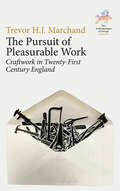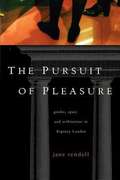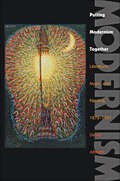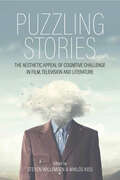- Table View
- List View
Purging the Poorest: Public Housing and the Design Politics of Twice-Cleared Communities (Historical Studies of Urban America)
by Lawrence J. ValeThe building and management of public housing is often seen as a signal failure of American public policy, but this is a vastly oversimplified view. In Purging the Poorest, Lawrence J. Vale offers a new narrative of the seventy-five-year struggle to house the “deserving poor.” In the 1930s, two iconic American cities, Atlanta and Chicago, demolished their slums and established some of this country’s first public housing. Six decades later, these same cities also led the way in clearing public housing itself. Vale’s groundbreaking history of these “twice-cleared” communities provides unprecedented detail about the development, decline, and redevelopment of two of America’s most famous housing projects: Chicago’s Cabrini-Green and Atlanta’s Techwood /Clark Howell Homes. Vale offers the novel concept of design politics to show how issues of architecture and urbanism are intimately bound up in thinking about policy. Drawing from extensive archival research and in-depth interviews, Vale recalibrates the larger cultural role of public housing, revalues the contributions of public housing residents, and reconsiders the role of design and designers.
Purging the Poorest: Public Housing and the Design Politics of Twice-Cleared Communities (Historical Studies of Urban America)
by Lawrence J. ValeThe building and management of public housing is often seen as a signal failure of American public policy, but this is a vastly oversimplified view. In Purging the Poorest, Lawrence J. Vale offers a new narrative of the seventy-five-year struggle to house the “deserving poor.” In the 1930s, two iconic American cities, Atlanta and Chicago, demolished their slums and established some of this country’s first public housing. Six decades later, these same cities also led the way in clearing public housing itself. Vale’s groundbreaking history of these “twice-cleared” communities provides unprecedented detail about the development, decline, and redevelopment of two of America’s most famous housing projects: Chicago’s Cabrini-Green and Atlanta’s Techwood /Clark Howell Homes. Vale offers the novel concept of design politics to show how issues of architecture and urbanism are intimately bound up in thinking about policy. Drawing from extensive archival research and in-depth interviews, Vale recalibrates the larger cultural role of public housing, revalues the contributions of public housing residents, and reconsiders the role of design and designers.
Purging the Poorest: Public Housing and the Design Politics of Twice-Cleared Communities (Historical Studies of Urban America)
by Lawrence J. ValeThe building and management of public housing is often seen as a signal failure of American public policy, but this is a vastly oversimplified view. In Purging the Poorest, Lawrence J. Vale offers a new narrative of the seventy-five-year struggle to house the “deserving poor.” In the 1930s, two iconic American cities, Atlanta and Chicago, demolished their slums and established some of this country’s first public housing. Six decades later, these same cities also led the way in clearing public housing itself. Vale’s groundbreaking history of these “twice-cleared” communities provides unprecedented detail about the development, decline, and redevelopment of two of America’s most famous housing projects: Chicago’s Cabrini-Green and Atlanta’s Techwood /Clark Howell Homes. Vale offers the novel concept of design politics to show how issues of architecture and urbanism are intimately bound up in thinking about policy. Drawing from extensive archival research and in-depth interviews, Vale recalibrates the larger cultural role of public housing, revalues the contributions of public housing residents, and reconsiders the role of design and designers.
Purging the Poorest: Public Housing and the Design Politics of Twice-Cleared Communities (Historical Studies of Urban America)
by Lawrence J. ValeThe building and management of public housing is often seen as a signal failure of American public policy, but this is a vastly oversimplified view. In Purging the Poorest, Lawrence J. Vale offers a new narrative of the seventy-five-year struggle to house the “deserving poor.” In the 1930s, two iconic American cities, Atlanta and Chicago, demolished their slums and established some of this country’s first public housing. Six decades later, these same cities also led the way in clearing public housing itself. Vale’s groundbreaking history of these “twice-cleared” communities provides unprecedented detail about the development, decline, and redevelopment of two of America’s most famous housing projects: Chicago’s Cabrini-Green and Atlanta’s Techwood /Clark Howell Homes. Vale offers the novel concept of design politics to show how issues of architecture and urbanism are intimately bound up in thinking about policy. Drawing from extensive archival research and in-depth interviews, Vale recalibrates the larger cultural role of public housing, revalues the contributions of public housing residents, and reconsiders the role of design and designers.
Purging the Poorest: Public Housing and the Design Politics of Twice-Cleared Communities (Historical Studies of Urban America)
by Lawrence J. ValeThe building and management of public housing is often seen as a signal failure of American public policy, but this is a vastly oversimplified view. In Purging the Poorest, Lawrence J. Vale offers a new narrative of the seventy-five-year struggle to house the “deserving poor.” In the 1930s, two iconic American cities, Atlanta and Chicago, demolished their slums and established some of this country’s first public housing. Six decades later, these same cities also led the way in clearing public housing itself. Vale’s groundbreaking history of these “twice-cleared” communities provides unprecedented detail about the development, decline, and redevelopment of two of America’s most famous housing projects: Chicago’s Cabrini-Green and Atlanta’s Techwood /Clark Howell Homes. Vale offers the novel concept of design politics to show how issues of architecture and urbanism are intimately bound up in thinking about policy. Drawing from extensive archival research and in-depth interviews, Vale recalibrates the larger cultural role of public housing, revalues the contributions of public housing residents, and reconsiders the role of design and designers.
'Purpose-built’ Art in Hospitals: Art with Intent
by Judy RollinsOver the past three decades, guidance on the selection of art in hospitals has suggested realistic art that depicts soothing and comforting images such as tranquil waters, green vegetation, flowers, and open spaces. Based on these findings, curators have been cautioned to avoid art with uncertain meaning that risks upsetting viewers in stressful states. However, some hospitals exhibit ambiguous or abstract art and cite anecdotal evidence of its appropriateness for healthcare settings. More recent research is going beyond anecdotal evidence, and indicates that the ambiguity of meaning in abstract compositions can have positive effects. 'Purpose-built' Art in Hospitals is built on an international study of artwork in hospitals around the globe. Exploring 'purpose-built' (specially commissioned) artwork in hospitals through the dual lens of an artist and healthcare professional, Rollins identifies 15 specific 'purposes' of visual artwork in hospitals and presents a compelling case for their use that is grounded in research. The book builds the reader's understanding of the many functions of artwork in hospitals, with the goal of encouraging greater variety in art offerings to better serve the many diverse needs of patients, families, visitors and staff within the hospital environment.
'Purpose-built’ Art in Hospitals: Art with Intent
by Judy RollinsOver the past three decades, guidance on the selection of art in hospitals has suggested realistic art that depicts soothing and comforting images such as tranquil waters, green vegetation, flowers, and open spaces. Based on these findings, curators have been cautioned to avoid art with uncertain meaning that risks upsetting viewers in stressful states. However, some hospitals exhibit ambiguous or abstract art and cite anecdotal evidence of its appropriateness for healthcare settings. More recent research is going beyond anecdotal evidence, and indicates that the ambiguity of meaning in abstract compositions can have positive effects. 'Purpose-built' Art in Hospitals is built on an international study of artwork in hospitals around the globe. Exploring 'purpose-built' (specially commissioned) artwork in hospitals through the dual lens of an artist and healthcare professional, Rollins identifies 15 specific 'purposes' of visual artwork in hospitals and presents a compelling case for their use that is grounded in research. The book builds the reader's understanding of the many functions of artwork in hospitals, with the goal of encouraging greater variety in art offerings to better serve the many diverse needs of patients, families, visitors and staff within the hospital environment.
The Pursuit of Pleasurable Work: Craftwork in Twenty-First Century England (New Anthropologies of Europe: Perspectives and Provocations #4)
by Trevor H. J. MarchandAgainst the backdrop of an alienating, technologizing and ever-accelerating world of material production, this book tells an intimate story: one about a community of woodworkers training at an historic institution in London’s East End during the present ‘renaissance of craftsmanship’. The animated and scholarly accounts of learning, achievement and challenges reveal the deep human desire to create with our hands, the persistent longing to find meaningful work, and the struggle to realise dreams. In its penetrating explorations of the nature of embodied skill, the book champions greater appreciation for the dexterity, ingenuity and intelligence that lie at the heart of craftwork.
The Pursuit of Pleasurable Work: Craftwork in Twenty-First Century England (New Anthropologies of Europe: Perspectives and Provocations #4)
by Trevor H. J. MarchandAgainst the backdrop of an alienating, technologizing and ever-accelerating world of material production, this book tells an intimate story: one about a community of woodworkers training at an historic institution in London’s East End during the present ‘renaissance of craftsmanship’. The animated and scholarly accounts of learning, achievement and challenges reveal the deep human desire to create with our hands, the persistent longing to find meaningful work, and the struggle to realise dreams. In its penetrating explorations of the nature of embodied skill, the book champions greater appreciation for the dexterity, ingenuity and intelligence that lie at the heart of craftwork.
The Pursuit of Pleasurable Work: Craftwork in Twenty-First Century England (New Anthropologies of Europe: Perspectives and Provocations #4)
by Trevor H. J. MarchandAgainst the backdrop of an alienating, technologizing and ever-accelerating world of material production, this book tells an intimate story: one about a community of woodworkers training at an historic institution in London’s East End during the present ‘renaissance of craftsmanship’. The animated and scholarly accounts of learning, achievement and challenges reveal the deep human desire to create with our hands, the persistent longing to find meaningful work, and the struggle to realise dreams. In its penetrating explorations of the nature of embodied skill, the book champions greater appreciation for the dexterity, ingenuity and intelligence that lie at the heart of craftwork.
The Pursuit of Pleasurable Work: Craftwork in Twenty-First Century England (New Anthropologies of Europe: Perspectives and Provocations #4)
by Trevor H. J. MarchandAgainst the backdrop of an alienating, technologizing and ever-accelerating world of material production, this book tells an intimate story: one about a community of woodworkers training at an historic institution in London’s East End during the present ‘renaissance of craftsmanship’. The animated and scholarly accounts of learning, achievement and challenges reveal the deep human desire to create with our hands, the persistent longing to find meaningful work, and the struggle to realise dreams. In its penetrating explorations of the nature of embodied skill, the book champions greater appreciation for the dexterity, ingenuity and intelligence that lie at the heart of craftwork.
The Pursuit Of Pleasure (PDF)
by Jane RendellThe Pursuit of Pleasure presents the figures of the rambler and the cyprian, the Eighteenth Century precursors to the Parisian flGneur and prostitute. The urban spaces traced by these figures were the clubs, sporting venues, operas, assembly rooms, street.
Push: Software Design and the Cultural Politics of Music Production
by Mike D'ErricoPush: Software Design and the Cultural Politics of Music Production shows how changes in the design of music software in the first decades of the twenty-first century shaped the production techniques and performance practices of artists working across media, from hip-hop and electronic dance music to video games and mobile apps. Emerging alongside developments in digital music distribution such as peer-to-peer file sharing and the MP3 format, digital audio workstations like FL Studio and Ableton Live introduced design affordances that encouraged rapid music creation workflows through flashy, "user-friendly" interfaces. Meanwhile, software such as Avid's Pro Tools attempted to protect its status as the "industry standard," "professional" DAW of choice by incorporating design elements from pre-digital music technologies. Other software, like Cycling 74's Max, asserted its alterity to "commercial" DAWs by presenting users with nothing but a blank screen. These are more than just aesthetic design choices. Push examines the social, cultural, and political values designed into music software, and how those values become embodied by musical communities through production and performance. It reveals ties between the maximalist design of FL Studio, skeuomorphic design in Pro Tools, and gender inequity in the music products industry. It connects the computational thinking required by Max, as well as iZotope's innovations in artificial intelligence, with the cultural politics of Silicon Valley's "design thinking." Finally, it thinks through what happens when software becomes hardware, and users externalize their screens through the use of MIDI controllers, mobile media, and video game controllers. Amidst the perpetual upgrade culture of music technology, Push provides a model for understanding software as a microcosm for the increasing convergence of globalization, neoliberal capitalism, and techno-utopianism that has come to define our digital lives.
Push: Software Design and the Cultural Politics of Music Production
by Mike D'ErricoPush: Software Design and the Cultural Politics of Music Production shows how changes in the design of music software in the first decades of the twenty-first century shaped the production techniques and performance practices of artists working across media, from hip-hop and electronic dance music to video games and mobile apps. Emerging alongside developments in digital music distribution such as peer-to-peer file sharing and the MP3 format, digital audio workstations like FL Studio and Ableton Live introduced design affordances that encouraged rapid music creation workflows through flashy, "user-friendly" interfaces. Meanwhile, software such as Avid's Pro Tools attempted to protect its status as the "industry standard," "professional" DAW of choice by incorporating design elements from pre-digital music technologies. Other software, like Cycling 74's Max, asserted its alterity to "commercial" DAWs by presenting users with nothing but a blank screen. These are more than just aesthetic design choices. Push examines the social, cultural, and political values designed into music software, and how those values become embodied by musical communities through production and performance. It reveals ties between the maximalist design of FL Studio, skeuomorphic design in Pro Tools, and gender inequity in the music products industry. It connects the computational thinking required by Max, as well as iZotope's innovations in artificial intelligence, with the cultural politics of Silicon Valley's "design thinking." Finally, it thinks through what happens when software becomes hardware, and users externalize their screens through the use of MIDI controllers, mobile media, and video game controllers. Amidst the perpetual upgrade culture of music technology, Push provides a model for understanding software as a microcosm for the increasing convergence of globalization, neoliberal capitalism, and techno-utopianism that has come to define our digital lives.
Pushkin's Boris Godunov: Mozart And Salieri And A Stone Guest (Russian Texts)
by Alexander Pushkin Adrian MitchellMoscow 1598. The great Tsar Ivan the Terrible has died and Boris Godunov reluctantly, humbly takes the throne. But rumours are rife that Boris has secretly murdered the rightful heir and the distant shadow of this prodigal son threatens to close in and take revenge. Pushkin wrote Boris Godunov, with its beautiful echoes of Shakespeare’s Histories and Macbeth, during the political turmoil of the 1820s in Russia.
Pussy Sludge (Modern Plays)
by Gracie GardnerPussy Sludge is a play about a woman with a broken pussy.There's a woman menstruating crude oil. She lives in a swamp. She's in love with Courtney, but her mother prefers RJ.No one knows who knows what's best.Gracie Gardner's award-winning play sketches a dystopian setting with an eponymous main character who, in a number of absurd encounters, resists stereotypical gender constructions and socially predetermined life models. Farmore than just a feisty criticism of patriarchal systems, the play turns power structures upside down and offers a surreal and comic parable of sexual self-determination that challenges conservative gender constructs and our patriarchal status quo with vigor and irony.Pussy Sludge is a tender exploration of questioning authority, suspending shame through intimacy, and very bad advice.
Pussy Sludge (Modern Plays)
by Gracie GardnerPussy Sludge is a play about a woman with a broken pussy.There's a woman menstruating crude oil. She lives in a swamp. She's in love with Courtney, but her mother prefers RJ.No one knows who knows what's best.Gracie Gardner's award-winning play sketches a dystopian setting with an eponymous main character who, in a number of absurd encounters, resists stereotypical gender constructions and socially predetermined life models. Farmore than just a feisty criticism of patriarchal systems, the play turns power structures upside down and offers a surreal and comic parable of sexual self-determination that challenges conservative gender constructs and our patriarchal status quo with vigor and irony.Pussy Sludge is a tender exploration of questioning authority, suspending shame through intimacy, and very bad advice.
Putting Modernism Together: Literature, Music, and Painting, 1872–1927 (Hopkins Studies in Modernism)
by Daniel AlbrightHow do you rationally connect the diverse literature, music, and painting of an age? Throughout the modernist era�which began roughly in 1872 with the Franco-Prussian War, climaxed with the Great War, and ended with a third catastrophe, the Great Depression�there was a special belligerence to this question. It was a cultural period that envisioned many different models of itself: to the Cubists, it looked like a vast jigsaw puzzle; to the Expressionists, it resembled a convulsive body; to the Dadaists, it brought to mind a heap of junk following an explosion. In Putting Modernism Together, Daniel Albright searches for the center of the modernist movement by assessing these various artistic models, exploring how they generated a stunning range of creative work that was nonetheless wound together aesthetically, and sorting out the cultural assumptions that made each philosophical system attractive. Emerging from Albright's lectures for a popular Harvard University course of the same name, the book investigates different methodologies for comparing the evolution and congruence of artistic movements by studying simultaneous developments that occurred during particularly key modernist years. What does it mean, Albright asks, that Joseph Conrad's Heart of Darkness, published in 1899, appeared at the same time as Claude Debussy's Nocturnes�beyond the fact that the word "Impressionist" has been used to describe each work? Why, in 1912, did the composer Arnold Schoenberg and the painter Vassily Kandinsky feel such striking artistic kinship? And how can we make sense of a movement, fragmented by isms, that looked for value in all sorts of under- or ill-valued places, including evil (Baudelaire), dung heaps (Chekhov), noise (Russolo), obscenity (Lawrence), and triviality (Satie)? Throughout Putting Modernism Together, Albright argues that human culture can best be understood as a growth-pattern or ramifying of artistic, intellectual, and political action. Going beyond merely explaining how the artists in these genres achieved their peculiar effects, he presents challenging new analyses of telling craft details which help students and scholars come to know more fully this bold age of aesthetic extremism.
Puzzle Films: Complex Storytelling in Contemporary Cinema
by Warren BucklandDrawing upon the expertise of film scholars from around the world, Puzzle Films investigates a number of films that sport complex storytelling--from Memento, Old Boy, and Run Lola Run, to the Infernal Affairs trilogy and In the Mood for Love. Unites American ‘independent’ cinema, the European and International Art film, and certain modes of avant-garde filmmaking on the basis of their shared storytelling complexity Draws upon the expertise of film scholars from North America, Britain, China, Poland, Holland, Italy, Greece, New Zealand, and Australia
Puzzling Stories: The Aesthetic Appeal of Cognitive Challenge in Film, Television and Literature
by Steven Willemsen Miklós KissMany films and novels defy our ability to make sense of the plot. While puzzling storytelling, strange incongruities, inviting enigmas and persistent ambiguities have been central to the effects of many literary and cinematic traditions, a great deal of contemporary films and television series bring such qualities to the mainstream—but wherein lies the attractiveness of perplexing works of fiction? This collected volume offers the first comprehensive, multidisciplinary, and trans-medial approach to the question of cognitive challenge in narrative art, bringing together psychological, philosophical, formal-historical, and empirical perspectives from leading scholars across these fields.
Puzzling Stories: The Aesthetic Appeal of Cognitive Challenge in Film, Television and Literature
by Steven Willemsen Miklós KissMany films and novels defy our ability to make sense of the plot. While puzzling storytelling, strange incongruities, inviting enigmas and persistent ambiguities have been central to the effects of many literary and cinematic traditions, a great deal of contemporary films and television series bring such qualities to the mainstream—but wherein lies the attractiveness of perplexing works of fiction? This collected volume offers the first comprehensive, multidisciplinary, and trans-medial approach to the question of cognitive challenge in narrative art, bringing together psychological, philosophical, formal-historical, and empirical perspectives from leading scholars across these fields.
Puzzling Stories: The Aesthetic Appeal of Cognitive Challenge in Film, Television and Literature
by Steven Willemsen Miklós KissMany films and novels defy our ability to make sense of the plot. While puzzling storytelling, strange incongruities, inviting enigmas and persistent ambiguities have been central to the effects of many literary and cinematic traditions, a great deal of contemporary films and television series bring such qualities to the mainstream—but wherein lies the attractiveness of perplexing works of fiction? This collected volume offers the first comprehensive, multidisciplinary, and trans-medial approach to the question of cognitive challenge in narrative art, bringing together psychological, philosophical, formal-historical, and empirical perspectives from leading scholars across these fields.
Puzzling Stories: The Aesthetic Appeal of Cognitive Challenge in Film, Television and Literature
by Steven Willemsen Miklós KissMany films and novels defy our ability to make sense of the plot. While puzzling storytelling, strange incongruities, inviting enigmas and persistent ambiguities have been central to the effects of many literary and cinematic traditions, a great deal of contemporary films and television series bring such qualities to the mainstream—but wherein lies the attractiveness of perplexing works of fiction? This collected volume offers the first comprehensive, multidisciplinary, and trans-medial approach to the question of cognitive challenge in narrative art, bringing together psychological, philosophical, formal-historical, and empirical perspectives from leading scholars across these fields.
Puzzling Stories: The Aesthetic Appeal of Cognitive Challenge in Film, Television and Literature
by Steven Willemsen Miklós KissMany films and novels defy our ability to make sense of the plot. While puzzling storytelling, strange incongruities, inviting enigmas and persistent ambiguities have been central to the effects of many literary and cinematic traditions, a great deal of contemporary films and television series bring such qualities to the mainstream—but wherein lies the attractiveness of perplexing works of fiction? This collected volume offers the first comprehensive, multidisciplinary, and trans-medial approach to the question of cognitive challenge in narrative art, bringing together psychological, philosophical, formal-historical, and empirical perspectives from leading scholars across these fields.
The Pygmalion Effect: From Ovid to Hitchcock (Louise Smith Bross Lecture Series)
by Victor I. StoichitaBetween life and the art that imitates it is a vague, more shadowy category: images that exist autonomously. Pygmalion’s mythical sculpture, which magnanimous gods endowed with life after he fell in love with it, marks perhaps the first such instance in Western art history of an image that exists on its own terms, rather than simply imitating something (or someone) else. In The Pygmalion Effect, Victor I. Stoichita delivers this living image—as well as its many avatars over the centuries—from the long shadow cast by art that merely replicates reality. Stoichita traces the reverberations of Ovid’s founding myth from ancient times through the advent of cinema. Emphasizing its erotic origins, he locates echoes of this famous fable in everything from legendary incarnations of Helen of Troy to surrealist painting to photographs of both sculpture and people artfully posed to simulate statues. But it was only with the invention of moving pictures, Stoichita argues, that the modern age found a fitting embodiment of the Pygmalion story’s influence. Concluding with an analysis of Alfred Hitchcock films that focuses on Kim Novak’s double persona in Vertigo, The Pygmalion Effect illuminates the fluctuating connections that link aesthetics, magic, and technical skill. In the process, it sheds new light on a mysterious world of living artifacts that, until now, has occupied a dark and little-understood realm in the history of Western image making.












